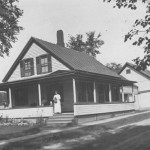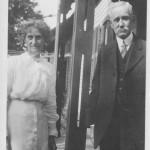Welcome to February’s edition of History & Heritage. Our purpose is to acquaint you with our mission to preserve the town’s rich history, highlight the legacy of those who have gone before and show how our past has shaped our present. We are a non-profit with 501(c)(3) status.
We are located in the Summer Street School building while renovations are being made before we move to our new permanent home at 421 Summer Street. It took a community along with friends and alumni to make this dream a reality. We encourage your support in making this historic home a wonderful place for exhibiting, preserving and collecting St. Johnsbury’s history. To date, we have a new floor in the barn, wiring for the fire alarm is complete and work is continuing in the classroom/meeting room in the back; a handicapped bathroom is being readied while drawings and manufacture of cabinets to hold the exhibits for display are ongoing. Check out our web site at www.stjhistory.org and our Facebook page. Our mailing address is P.O. Box 223, St. Johnsbury, Vt., 05819 and phone number is 802 – 424 – 1090.
John Green
This month’s story is a result of sifting through a box given to History & Heritage “for whatever might be of interest “ in St. Johnsbury’s past. An oval, gray, metal plaque caught my eye. The design imprinted on it suggested a coffin with some type of urn on the top and within the suggested coffin were the words
“Died for his Country.
John Green.
Aged 23 yrs. 7 mos.”

My guess was this plaque was on his coffin and removed prior to his burial. Continuing the search of the box, I found a letter from the U. S. Christian Commission addressed to Mr. Wm. Green, St. Johnsbury Vermont. The inside letter has a picture of a dove with a letter attached around its neck with words to the left quoted “The U. S. Christian Commission sends this as the soldier’s messenger to his home. Let it hasten to those who wait for tidings.” The letter is being sent from the U.S. Naval Hospital at Annapolis, Maryland with the date of Dec. 5th 1864 (now we are sure of the Civil War). The contents are not good with the first sentence starting “Your son, John Green, having arrived here a paroled prisoner from Savannah and being so sick with chronic diarrhea that doubts are entertained in regard to his recovery,…. “ He goes on to suggest that perhaps Mr. Green’s wife or daughter might come at once to see him and “have some care of him, as might save his life. By his request therefore I sent a telegraphic communication to you from Baltimore early, to have one or the other come.”


Further investigation of this box reveals the picture of the Green House on Green Street – the first house on the left as you enter Green Street, note the shed/ barn that is missing today.
bc v
Now the Green monument found on your right after entering the Mt. Pleasant entrance to the Cemetery takes on a whole new meaning. The stone itself reveals that John Green was a member of Co. A, 11th Vt. Regt who died at Annapolis, Md. Dec. 5, 1864, Aged 23 yrs, 7mos; son of William and Elizabeth Green. The date on the letter and the date on the stone give us understanding that no one got there in time. William did take the train to Annapolis but not in time to see him alive.
The St. Johnsbury Soldier’s Record compiled by Honorable Albert G. Chadwick tells us that John enlisted August 5, 1862, in Company A, 11th Regiment at the age of twenty-one years and three months. The 11th Regiment joined the Vermont Brigade at Spottsylvania, Virginia on the 15th of May and three days later was called to lead a charge of the brigade. This was John’s first fighting and he was part of all following engagements prior to his capture at Weldon Railroad on June 23, 1864. For the next five months he was a prisoner at Andersonville, Ga. Not that any prisons were good but conditions at Andersonville were perhaps the worse. I have stood on the grounds of Andersonville and tried to visualize 26,000 prisoners enclosed in the 26 acres – you can just imagine. Chadwick concludes his story of John with “It may be said of him and justly too, that he was a good soldier.”
Edward Fairbanks in his history of the town gives us a hint of young John prior to his enlistment. William, John’s father, had the care of Joseph P. Fairbanks’ herd of cows and began delivering a few cans of milk from the farm wagon which was driven by son John. This was the first regular distribution of milk in the town by wagon.
His body was brought home with a funeral held at the South Congregational Church and then taken to Mt. Pleasant for burial in the family lot. William would become the Superintendent of the Cemetery in 1871, serving for twenty years. The items found in the box provided more of the story of John Green and remind us of how we hang onto the tangible memories that help tell the story of St. Johnsbury and its people.




コメント